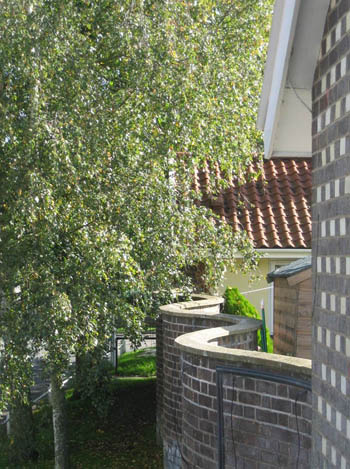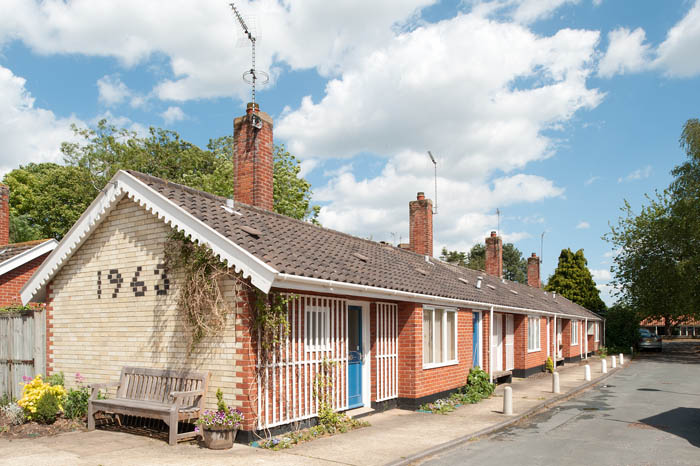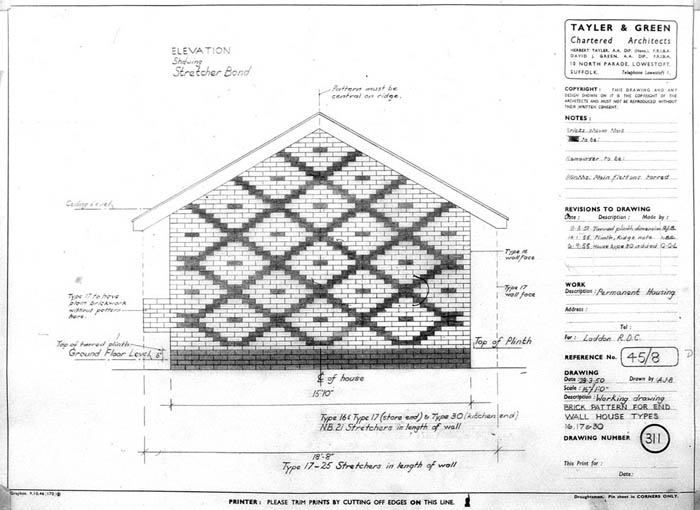Much has been written about how Tayler and Green’s work for Loddon fits so snugly into the Norfolk landscape, but a desire to ‘fit in’ was not a major driving-force behind their choice of forms and materials.
They liked the low-pitched roof because it reduced the profile of their buildings in the landscape, but it was also a cost-effective solution, using less timber than a steeper pitch and reducing the amount of brick-work on the gable. Good quality facing-bricks were in short supply after the war, so in the early projects painted Fletton bricks were used. This necessity was turned to a virtue: to add variety into the longer terraces buffs and creams were contrasted with pale blues and pinks. As Elaine Harwood explains in ‘Tayler and Green Architects: The Spirit of Place in Modern Housing’:
Later the colours became stronger, culminating in 1950 at Hales where, in memory of the Black Death, Tayler instructed that one house be tarred black, and set next to more painted Exelaero ‘Pantile Red’. He recalls his concern that the house might prove un-lettable – and his joy when its first occupant boldly hung bright orange curtains at the windows.
 The conscious connection with history is interesting in this anecdote. Whilst the houses were clearly modern in their conception, Tayler and Green were not afraid of borrowing from the vernacular. They often used crinkle-crankle walls (right) – for good practical reasons as well as aesthetics – and they became very fond of decorative fret-cut barge-boards, most common in Norfolk on Victorian cottage-style buildings. The elaboration and enjoyment of the gable emerged as the real Tayler and Green trade-mark, setting them apart from mainstream modern movement which remains, even today, positively phobic of pitched roofs and is only latterly coming to appreciate the potential of pattern.
The conscious connection with history is interesting in this anecdote. Whilst the houses were clearly modern in their conception, Tayler and Green were not afraid of borrowing from the vernacular. They often used crinkle-crankle walls (right) – for good practical reasons as well as aesthetics – and they became very fond of decorative fret-cut barge-boards, most common in Norfolk on Victorian cottage-style buildings. The elaboration and enjoyment of the gable emerged as the real Tayler and Green trade-mark, setting them apart from mainstream modern movement which remains, even today, positively phobic of pitched roofs and is only latterly coming to appreciate the potential of pattern.
Tayler and Green used traditional diaper-work (diamond-patterns) and their own variants on it, sometimes with projecting bricks as well as coloured ones, dates and occasionally ‘signing’ their own buildings with inscribed bricks. At Davy Place, bottle-bottoms were set into the wall, recalling the site’s former use as a town dump! Although the patterns were tightly specified, Tayler observed:
…the men noticeably sing while building them, and take immense pains to get them rightly bonded.

Above: Dated gable, fret-cut barge-boards and a front door trellis at Davy Place, Loddon (Photo: Jim Stephenson, Click-click Jim)
Next: Tayler and Green #9 – Composition
More on Tayler and Green’s enjoyment of pattern here.

Next:
More on Pattern
